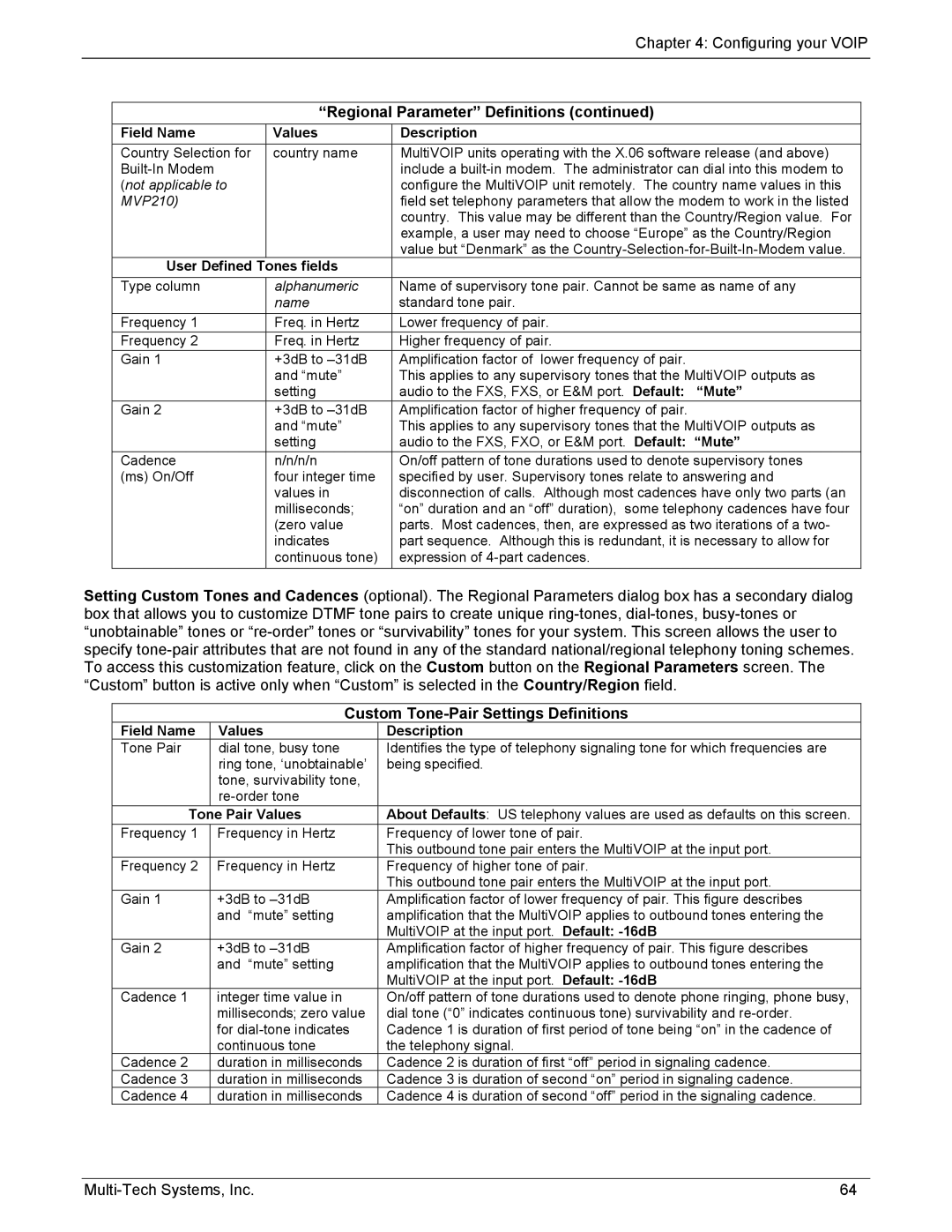
|
|
| Chapter 4: Configuring your VOIP | |
|
|
|
|
|
|
|
|
|
|
|
| “Regional Parameter” Definitions (continued) | ||
| Field Name | Values | Description |
|
| Country Selection for | country name | MultiVOIP units operating with the X.06 software release (and above) |
|
|
| include a |
| |
| (not applicable to |
| configure the MultiVOIP unit remotely. The country name values in this |
|
| MVP210) |
| field set telephony parameters that allow the modem to work in the listed |
|
|
|
| country. This value may be different than the Country/Region value. For |
|
|
|
| example, a user may need to choose “Europe” as the Country/Region |
|
|
|
| value but “Denmark” as the |
|
| User Defined | Tones fields |
|
|
| Type column | alphanumeric | Name of supervisory tone pair. Cannot be same as name of any |
|
|
| name | standard tone pair. |
|
| Frequency 1 | Freq. in Hertz | Lower frequency of pair. |
|
| Frequency 2 | Freq. in Hertz | Higher frequency of pair. |
|
| Gain 1 | +3dB to | Amplification factor of lower frequency of pair. |
|
|
| and “mute” | This applies to any supervisory tones that the MultiVOIP outputs as |
|
|
| setting | audio to the FXS, FXS, or E&M port. Default: “Mute” |
|
| Gain 2 | +3dB to | Amplification factor of higher frequency of pair. |
|
|
| and “mute” | This applies to any supervisory tones that the MultiVOIP outputs as |
|
|
| setting | audio to the FXS, FXO, or E&M port. Default: “Mute” |
|
| Cadence | n/n/n/n | On/off pattern of tone durations used to denote supervisory tones |
|
| (ms) On/Off | four integer time | specified by user. Supervisory tones relate to answering and |
|
|
| values in | disconnection of calls. Although most cadences have only two parts (an |
|
|
| milliseconds; | “on” duration and an “off” duration), some telephony cadences have four |
|
|
| (zero value | parts. Most cadences, then, are expressed as two iterations of a two- |
|
|
| indicates | part sequence. Although this is redundant, it is necessary to allow for |
|
|
| continuous tone) | expression of |
|
Setting Custom Tones and Cadences (optional). The Regional Parameters dialog box has a secondary dialog box that allows you to customize DTMF tone pairs to create unique
Custom Tone-Pair Settings Definitions
Field Name | Values |
Tone Pair | dial tone, busy tone |
| ring tone, ‘unobtainable’ |
| tone, survivability tone, |
| |
Tone Pair Values | |
Frequency 1 | Frequency in Hertz |
|
|
Frequency 2 | Frequency in Hertz |
|
|
Gain 1 | +3dB to |
| and “mute” setting |
|
|
Gain 2 | +3dB to |
| and “mute” setting |
|
|
Cadence 1 | integer time value in |
| milliseconds; zero value |
| for |
| continuous tone |
Cadence 2 | duration in milliseconds |
Cadence 3 | duration in milliseconds |
Cadence 4 | duration in milliseconds |
Description
Identifies the type of telephony signaling tone for which frequencies are being specified.
About Defaults: US telephony values are used as defaults on this screen.
Frequency of lower tone of pair.
This outbound tone pair enters the MultiVOIP at the input port. Frequency of higher tone of pair.
This outbound tone pair enters the MultiVOIP at the input port. Amplification factor of lower frequency of pair. This figure describes amplification that the MultiVOIP applies to outbound tones entering the MultiVOIP at the input port. Default:
Amplification factor of higher frequency of pair. This figure describes amplification that the MultiVOIP applies to outbound tones entering the MultiVOIP at the input port. Default:
On/off pattern of tone durations used to denote phone ringing, phone busy, dial tone (“0” indicates continuous tone) survivability and
Cadence 2 is duration of first “off” period in signaling cadence. Cadence 3 is duration of second “on” period in signaling cadence. Cadence 4 is duration of second “off” period in the signaling cadence.
64 |
